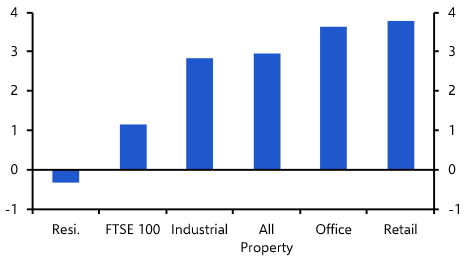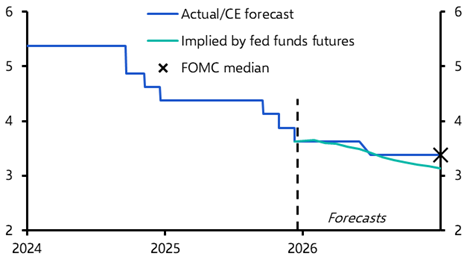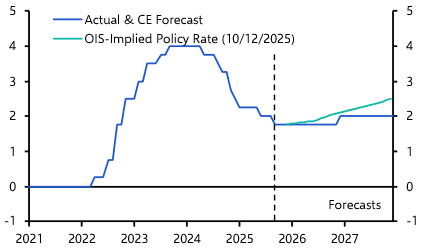Last week I argued that, although inflation in advanced economies is likely to rebound this year, this should not be mistaken for the start of a new post-pandemic era of higher inflation. However, this is clearly not the same as saying there will not be a period of higher inflation in some economies at some point in the future. How seriously should we take this threat?
It’s important to distinguish between a short-lived jump in inflation caused by a one-off shift in prices and a more permanent acceleration in inflation caused by a broader rise in prices that is sustained over many years. The former can be caused by moves in global commodity markets, changes in indirect tax rates or fluctuations in exchange rates. These are, to varying extents, the drivers of the rebound in advanced economy inflation that we anticipate this year, and they tend to be temporary in nature. They do not form the underpinnings of a new era of permanently higher inflation. This only becomes possible if aggregate demand is allowed to run ahead of potential supply such that it puts upward pressure on prices over many years. Inflation expectations can then increase, setting in train a wage-price spiral that makes the anticipation of further increases in inflation a self-fulfilling prophecy.
This balance between aggregate demand and potential supply is unlikely to put upward pressure on prices over the next couple of years. Price pressures may emerge in sectors that are most affected by ongoing social distancing measures and/or shifts in consumption patterns. But most economies are likely to operate below full employment (or, to use the jargon, have negative “output gaps”) in 2021-22. This should prevent a significant acceleration in overall core inflation.
However, there are several ways in which the balance between demand and supply could become more inflationary later this decade. The big decline in inflation over the past thirty years owed a lot to supply-side developments. The integration of China and other large emerging economies into the world trading system, combined with a decline in union power and an increase in labour market flexibility in advanced economies, and the spread of new technologies more generally, put downward pressure on prices across large swathes of the world economy. Some of the downward pressure from globalisation is likely to fade over the coming years. But it’s possible that this is replaced with other supply-side sources of disinflation. In particular, we remain optimistic about a technology-led pick-up in productivity later this decade.
Instead, the bigger risks to inflation over the medium-term stem from what may happen on the demand side of the economy. The scale of the stimulus that has been pumped into the global economy over the past year has, by any measure, been enormous. The IMF estimates that fiscal support measures by governments in the wake of the pandemic have totalled 12% of global GDP. This compares to fiscal support of “only” 2% of world GDP in the wake of the global financial crisis in 2009. At the same time, central banks have engineered a huge monetary expansion. Asset purchases by the Fed, ECB, BoJ and Bank of England have totalled $4.8trn over the past year – equivalent to more than 5% of global GDP.
This combination of monetary expansion alongside fiscal expansion has meant that, unlike in previous rounds of QE, the money that has been created by central banks has found its way into the real economy rather than just getting stuck in the financial system.
For now, this is being stored as savings and is showing up as an increase in household and corporate deposits. But a run-down of these savings would give a huge boost to demand. We estimate that if households spent the savings they have accumulated in the crisis it would boost consumer spending by 3-5% of GDP in the US, UK and euro-zone.
If this then led to inflation central banks could respond by tightening policy – either by destroying the additional bank reserves that have been created through asset purchases (i.e. engaging in quantitative tightening) or by choking off money demand by raising interest rates. Governments could also tighten fiscal policy. But both governments and central banks will come under pressure to keep policy loose.
In the case of governments, the pandemic has increased pressure on the state to provide adequate healthcare and tackle deeper-seated problems such as inequality. In the case of central banks, the huge rise in the public debt burden over the past year means a period of ultra-low real interest rates will be required to keep the public finances on an even keel. This may ultimately require governments and central banks to resort to financial repression. If one consequence of this is a rise in inflation, then this may come to be viewed as a price worth paying to achieve other policy goals. Indeed, to the extent that nominal bond yields can be kept in check, higher inflation will over time help to erode the real value of the public debt burden.
It’s easy to overdo much of this, and the worst fears of the increasingly vocal inflation hawks are unlikely to materialise. For a start, not all of the savings that have been accumulated in the crisis are likely to be run down. (See here for more.)
More importantly, with inflation expectations entrenched at low levels and the Phillips Curve if not dead then still pretty flat, it will take enormous effort to raise inflation on a sustained basis. The experience of Japan is well documented. But it’s also worth remembering that the US embarked on a large fiscal stimulus in 2017 when the economy was at full employment and there was little sign of a subsequent pick-up in inflation. It’s even more difficult to foresee a surge in inflation in the euro-zone, where the architecture of monetary union has tended to embed ultra-low rates of inflation (and even deflation) in peripheral countries.
There is understandable concern that once central banks let the inflation genie out of the bottle it will sky-rocket. But these structural headwinds mean that warnings about a return to 1970s-style rates of inflation look overdone. By the same token, however, the consensus view that inflation will return to and then settle at pre-pandemic rates of 1-2% in advanced economies looks complacent. That may be true in the euro-zone. But as attitudes among policymakers shift, it seems increasingly likely that inflation in other advanced economies, including the US and UK, will exceed pre-pandemic norms over the next decade.
In case you missed it:
- Our China team argues that the recent surge in interbank rates cannot be fully explained by seasonal tightening ahead of the Lunar New Year and instead signals a hawkish shift by the PBOC.
- Our Senior Europe Economist, Jack Allen-Reynolds, picks apart the upside surprise in euro-zone inflation in December – and assesses the implications for inflation this year.
- Our Senior EM Economist, Edward Glossop, argues that the big rebound in emerging market exports is now behind us.




